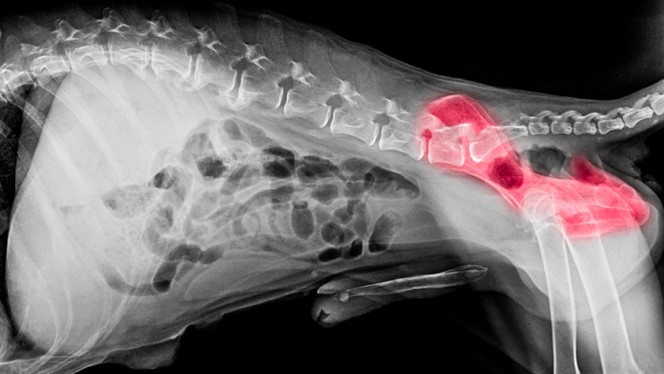A vet’s guide to hip dysplasia in dogs
Hip dysplasia in dogs is a painful condition, with long-term consequences. Here’s how to spot it and what can be done

Hip dysplasia in dogs is a genetic condition in which the hip joints don’t develop properly. Hip dysplasia is usually diagnosed in puppies at around 6-12 months old, but mild cases may not be detected until later in life. It is usually found in larger breeds, such as Labrador Retrievers or German Shepherds. However, any breed can be affected.
There are both surgical and medical treatments available, depending on how severe the dysplasia is. Often, the sooner hip dysplasia is diagnosed and treated, the better the outcome. Symptoms can be mild and hard to spot, so it’s important to know what to watch out for.
- A vet's guide to Osteoarthritis in cats
- A vet’s guide to Parvovirus in puppies
- Six tips for coping with arthritis in dogs: A vet's guide
What is hip dysplasia in dogs?
‘Dysplasia’ means abnormal growth or development. So ‘hip dysplasia’ is when the hip joints don’t develop properly. Usually, it affects both hips. It is partly a genetic condition, meaning it is inherited. However, there are other factors that can influence how badly affected an individual is, such as obesity and early-life exercise.
The hip is a ‘ball and socket’ joint. The ‘ball’ is the top of the thigh bone and it sits in the ‘socket’, which is in the hip bone. In hip dysplasia, the hips are normal at birth, but within a few weeks the soft tissues which should hold the joint together (the ligaments and joint capsule) become loose.
When the joint becomes unstable in this way, the bones rub against each other rather than sliding smoothly. This causes the ‘ball’ and the ‘socket’ to become deformed. The ‘ball’ becomes flattened and the ‘socket’ too shallow. As you can imagine, this can be painful!
Over time, this lack of stability and lack of smooth movement causes the cartilage to erode. It can even cause tiny fractures. Sadly, this means that all dogs with hip dysplasia will suffer from osteoarthritis too.
How do dogs get hip dysplasia?
Hip dysplasia is thought to be a genetic condition. This means that a gene for hip dysplasia is inherited from one, or both, parents. Some large-breed dogs are more prone to carrying these genes and so are more commonly affected. However, any breed can be affected, including cross breeds. Breeds at highest risk include Golden Retrievers, Labradors, German Shepherds, Rottweilers, Saint Bernards, and Great Danes.
Outside factors, such as if the dog is overweight or over-exercising as a puppy, cannot cause hip dysplasia. However, they can affect how much of a problem the hip dysplasia becomes. For example, obesity puts extra pressure on the joints, which will worsen the condition.
Symptoms of hip dysplasia in dogs
The symptoms of hip dysplasia can vary. It is not uncommon for dogs to show no signs of pain at home, but be very painful during a veterinary exam. So don’t be surprised if your vet suspects hip dysplasia if your dog isn’t even lame. It’s not your fault for not spotting it, and your vet isn’t wrong to suspect hip dysplasia from clinical exam findings.
The symptoms of hip dysplasia in dogs include:
- Limping on either, or both, back legs
- Stiffness when getting up
- Difficulty lying down
- Difficulty walking up and down stairs
- Difficulty jumping
- An unusual gait, such as swaying or ‘bunny hopping’, where both back legs move together
- A reluctance to exercise
The severity of these symptoms can vary from mild to severe. Sometimes symptoms may not be noticeable until later in life, when arthritis develops as a result of the changes in the hip.
If you suspect your puppy or dog may be suffering with hip dysplasia then arrange a check-up with your vet. If they agree, they will advise some x-rays under anaesthetic to assess the hip joints. It is important to note that clinical symptoms do not always match what the x-rays show.
Treating hip dysplasia in dogs

There’s no NHS for pets. Veterinary care can be eye-wateringly expensive and most pets will need treatment for an illness or injury at some point in their life. It’s difficult to think about your animals being hurt or unwell, but you need to ask yourself: what would you do if you were faced with a vet bill for hundreds or thousands of pounds?
Treatment is divided into non-surgical and surgical. Non-surgical treatment can be considered in dogs with mild or no symptoms, in cases which are detected late in life and cases where the cost of surgery is prohibitive. Unfortunately, while non-surgical management can be very effective, the disease will progress, and treatment will usually be lifelong.
Non-surgical treatments include anti-inflammatory pain relief alongside physiotherapy or hydrotherapy. Weight control will reduce the pressure on the joints and ease the pain too. Exercising little and often and avoiding jumping reduces pressure on the joints while keeping the joints moving. Swimming is good exercise, since it helps to strengthen the joints without putting pressure on them. Joint supplements containing glucosamine, chondroitin, green-lipped muscle and omega-3 fatty acids can be effective at slowing down the progression of arthritis.
Surgery is often recommended in puppies diagnosed with hip dysplasia who are showing symptoms, or when non-surgical treatment doesn’t work. There are several surgical options available, usually performed by a specialist surgeon. This includes a total hip replacement, where the joint is replaced with a prosthetic version.
If your dog is diagnosed with hip dysplasia, your veterinarian will discuss with you the best treatment options for your dog.

Tips on preventing hip dysplasia in dogs
Hip dysplasia can only be prevented by not breeding from affected dogs. There is a hip dysplasia scheme run by the British Veterinary Association (BVA), which uses x-rays to allow breeders to screen for hip dysplasia before breeding. Dogs are then given a score for each hip. To be bred, the dog’s score should be lower than average for the breed.
If you are thinking about getting a medium to large-breed puppy, you should always ask the breeder about the parent’s hip scores, and ask to see the certificates.
Final thoughts
Hip dysplasia is a painful genetic condition requiring lifelong treatment. Symptoms can vary from none to severe pain. The pain comes from the condition itself, as well as the arthritis that develops as a consequence. Luckily, there are several very effective surgical and medical treatments available. With successful treatment, your dog can still lead a long and happy life.
Since symptoms can be hard to spot at home, so it’s important to discuss any concerns with your vet as soon as possible, however minor they may seem. Often, the sooner hip dysplasia is diagnosed and treated, the better the outcome!
PetsRadar Newsletter
Get the best advice, tips and top tech for your beloved Pets
Sarah-Jane Molier graduated in 2009 and has been enjoying life as a vet ever since. She currently works as Head Veterinarian in a small animal practice. Sarah-Jane particular enjoys internal medicine, alongside her managerial role. When not working in practice Sarah-Jane enjoys sharing her knowledge and helping pet parents by writing on a wide variety of animal health and medicine topics. In her spare time Sarah-Jane loves walking Nero (her rescue dog), gardening with her two young children and reading.

